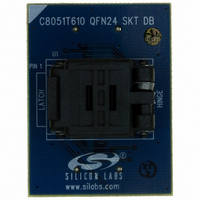C8051T610DB24 Silicon Laboratories Inc, C8051T610DB24 Datasheet - Page 158

C8051T610DB24
Manufacturer Part Number
C8051T610DB24
Description
DAUGHTER BOARD T610 24QFN SOCKET
Manufacturer
Silicon Laboratories Inc
Datasheet
1.C8051T610DB32.pdf
(218 pages)
Specifications of C8051T610DB24
Module/board Type
Socket Module - QFN
Processor To Be Evaluated
C8051T61x
Interface Type
USB
Lead Free Status / RoHS Status
Lead free / RoHS Compliant
For Use With/related Products
C8051T610DK
Lead Free Status / RoHS Status
Lead free / RoHS Compliant, Lead free / RoHS Compliant
Other names
336-1507
- Current page: 158 of 218
- Download datasheet (2Mb)
C8051T610/1/2/3/4/5/6/7
24.1. Signal Descriptions
The four signals used by SPI0 (MOSI, MISO, SCK, NSS) are described below.
24.1.1. Master Out, Slave In (MOSI)
The master-out, slave-in (MOSI) signal is an output from a master device and an input to slave devices. It
is used to serially transfer data from the master to the slave. This signal is an output when SPI0 is operat-
ing as a master and an input when SPI0 is operating as a slave. Data is transferred most-significant bit
first. When configured as a master, MOSI is driven by the MSB of the shift register in both 3- and 4-wire
mode.
24.1.2. Master In, Slave Out (MISO)
The master-in, slave-out (MISO) signal is an output from a slave device and an input to the master device.
It is used to serially transfer data from the slave to the master. This signal is an input when SPI0 is operat-
ing as a master and an output when SPI0 is operating as a slave. Data is transferred most-significant bit
first. The MISO pin is placed in a high-impedance state when the SPI module is disabled and when the SPI
operates in 4-wire mode as a slave that is not selected. When acting as a slave in 3-wire mode, MISO is
always driven by the MSB of the shift register.
24.1.3. Serial Clock (SCK)
The serial clock (SCK) signal is an output from the master device and an input to slave devices. It is used
to synchronize the transfer of data between the master and slave on the MOSI and MISO lines. SPI0 gen-
erates this signal when operating as a master. The SCK signal is ignored by a SPI slave when the slave is
not selected (NSS = 1) in 4-wire slave mode.
24.1.4. Slave Select (NSS)
The function of the slave-select (NSS) signal is dependent on the setting of the NSSMD1 and NSSMD0
bits in the SPI0CN register. There are three possible modes that can be selected with these bits:
1. NSSMD[1:0] = 00: 3-Wire Master or 3-Wire Slave Mode: SPI0 operates in 3-wire mode, and NSS is
2. NSSMD[1:0] = 01: 4-Wire Slave or Multi-Master Mode: SPI0 operates in 4-wire mode, and NSS is
3. NSSMD[1:0] = 1x: 4-Wire Master Mode: SPI0 operates in 4-wire mode, and NSS is enabled as an
See Figure 24.2, Figure 24.3, and Figure 24.4 for typical connection diagrams of the various operational
modes. Note that the setting of NSSMD bits affects the pinout of the device. When in 3-wire master or
3-wire slave mode, the NSS pin will not be mapped by the crossbar. In all other modes, the NSS signal will
be mapped to a pin on the device. See Section “21. Port Input/Output” on page 113 for general purpose
port I/O and crossbar information.
158
disabled. When operating as a slave device, SPI0 is always selected in 3-wire mode. Since no select
signal is present, SPI0 must be the only slave on the bus in 3-wire mode. This is intended for point-to-
point communication between a master and one slave.
enabled as an input. When operating as a slave, NSS selects the SPI0 device. When operating as a
master, a 1-to-0 transition of the NSS signal disables the master function of SPI0 so that multiple
master devices can be used on the same SPI bus.
output. The setting of NSSMD0 determines what logic level the NSS pin will output. This configuration
should only be used when operating SPI0 as a master device.
Rev 1.0
Related parts for C8051T610DB24
Image
Part Number
Description
Manufacturer
Datasheet
Request
R
Part Number:
Description:
SMD/C°/SINGLE-ENDED OUTPUT SILICON OSCILLATOR
Manufacturer:
Silicon Laboratories Inc
Part Number:
Description:
Manufacturer:
Silicon Laboratories Inc
Datasheet:
Part Number:
Description:
N/A N/A/SI4010 AES KEYFOB DEMO WITH LCD RX
Manufacturer:
Silicon Laboratories Inc
Datasheet:
Part Number:
Description:
N/A N/A/SI4010 SIMPLIFIED KEY FOB DEMO WITH LED RX
Manufacturer:
Silicon Laboratories Inc
Datasheet:
Part Number:
Description:
N/A/-40 TO 85 OC/EZLINK MODULE; F930/4432 HIGH BAND (REV E/B1)
Manufacturer:
Silicon Laboratories Inc
Part Number:
Description:
EZLink Module; F930/4432 Low Band (rev e/B1)
Manufacturer:
Silicon Laboratories Inc
Part Number:
Description:
I°/4460 10 DBM RADIO TEST CARD 434 MHZ
Manufacturer:
Silicon Laboratories Inc
Part Number:
Description:
I°/4461 14 DBM RADIO TEST CARD 868 MHZ
Manufacturer:
Silicon Laboratories Inc
Part Number:
Description:
I°/4463 20 DBM RFSWITCH RADIO TEST CARD 460 MHZ
Manufacturer:
Silicon Laboratories Inc
Part Number:
Description:
I°/4463 20 DBM RADIO TEST CARD 868 MHZ
Manufacturer:
Silicon Laboratories Inc
Part Number:
Description:
I°/4463 27 DBM RADIO TEST CARD 868 MHZ
Manufacturer:
Silicon Laboratories Inc
Part Number:
Description:
I°/4463 SKYWORKS 30 DBM RADIO TEST CARD 915 MHZ
Manufacturer:
Silicon Laboratories Inc
Part Number:
Description:
N/A N/A/-40 TO 85 OC/4463 RFMD 30 DBM RADIO TEST CARD 915 MHZ
Manufacturer:
Silicon Laboratories Inc
Part Number:
Description:
I°/4463 20 DBM RADIO TEST CARD 169 MHZ
Manufacturer:
Silicon Laboratories Inc










